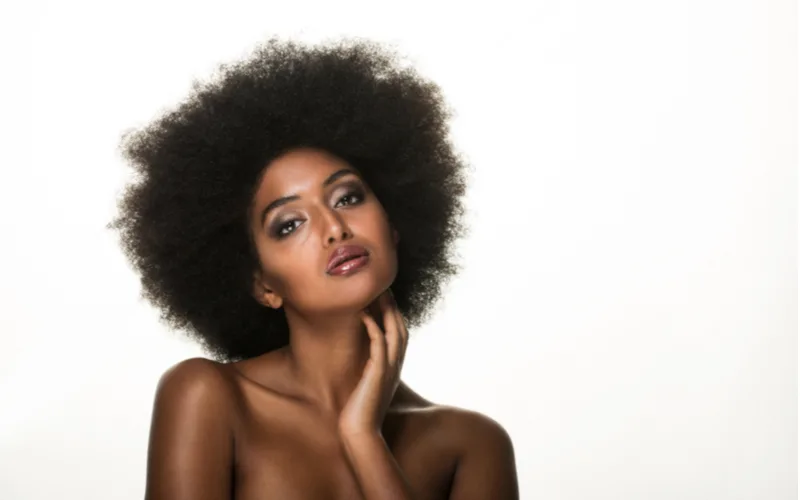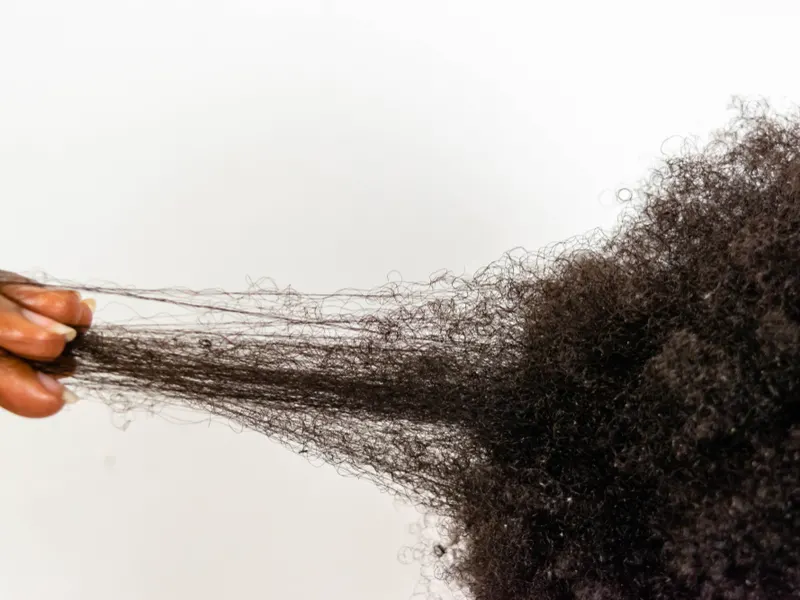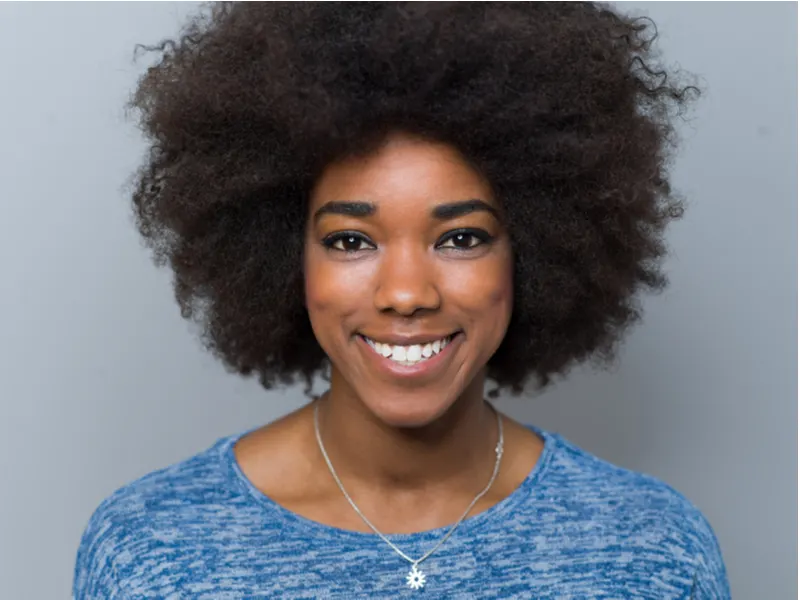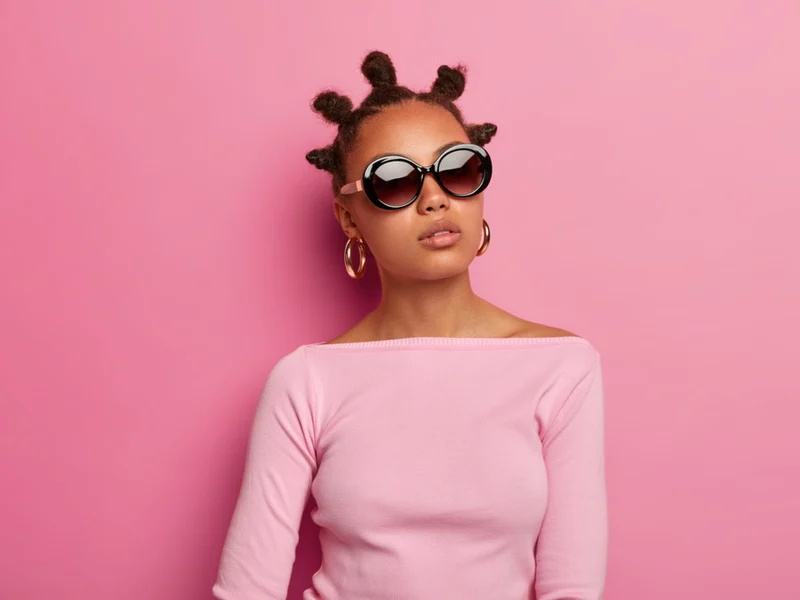Jump to:
Known for its ultra-tight kinky coils and never, ever low on volume, the 4C hair type is one of the most recognizable on the hair typing chart.
It presents some special challenges, so if you want to properly care for your 4C strands and combat dryness, breakage, and shrinkage, you need the tips in this quick reference guide!
What Is the 4C Hair Type?

Oneinchpunch/Shutterstock
The 4C hair type is known for its untameable volume and tight kinks in every strand. There’s very little definition in 4C kinks, which aren’t quite coils because of their sharply angled Z-shape.
This hair type deals with the most shrinkage of all type 4s. Your 4C strands may shrink up to 75% from wet to dry. This creates a massive difference in the length of your hair when it’s wet or stretched out vs. when it’s dry or unstretched.
Protective styles meant to gently stretch and bind your hair are ideal for the 4C hair type. Here are the general characteristics of 4C hair:
- Coarse strand texture with extremely tight kinks
- Very little kink/coil definition
- Full of natural volume and lift
- Prone to extreme dryness and frizz
- Most fragile hair type and prone to breakage
- Loses up to 75% of length as it dries (shrinkage)
The 4C hair type requires special care and maintenance to make it more manageable. Some people with this hair type turn to relaxers and chemical straightening treatments to tweak the texture and make it easier to care for.
But there’s something really special about skipping chemical treatments in favor of learning how to give your 4C strands exactly what they’re craving so you can rock your natural texture. That’s what you’ll learn in this quick reference guide!
Not sure if you’re really a 4C? You might be a 4B instead, or have characteristics of both 4B and 4C. Here’s how these two similar hair types compare.
- Type 4B: Medium-coarse, very tight Z-shaped coils; textured with a few defined coils throughout and some shrinkage
- Type 4C: Coarse texture with extremely tight kinky coils that have little definition; highly textured with up to 75% shrinkage as it dries
Best Features of 4C Hair
What’s the best thing about having 4C hair? We can’t narrow it down to just one, so here are the 3 traits we love the most about 4C hair.
Full of Natural Volume and Lift
The 4C hair type is bursting with natural lift and volume from root to tip. The ultra-kinky shape of 4C strands raises each strand at the root and prevents your strands from lying flat or clumping together.
Instead, your strands stand apart and create a dense mat of texture that is the perfect base for afro styles and just about any protective style you can think of.
Your hair’s natural volume means you’ll never deal with limp, lifeless locks that look greasy or cling to your scalp. Instead, you get sky-high lift and texture that can “fill out” any afro style, braid, twist, or loc for a healthy, full look.
Coarse Texture Lends Natural Damage Protection
Your 4C strands have a coarse texture, so each strand is thicker than a thread. This coarseness may make your strands feel a little rough or wiry to the touch, but it also provides extra damage protection naturally.
That’s because coarse-textured hair is the only texture that has all 3 layers of the hair shaft present: The outermost cuticle, the inner cortex, and the innermost medulla.
Fine and medium hair usually don’t have the medulla layer, so they’re much more susceptible to different types of damage (heat, chemical, physical, etc.). When you apply heat or chemicals to your coarse strands, it takes longer for damage to take effect because each strand is so healthy and thick.
Don’t take this as an invitation to see how much damage your hair can handle, though. Remember that 4C hair is also the most physically fragile type and needs to be handled gently to avoid breakage.
Ideal Hair Type for Protective Styles
While some hair types easily slip out of short- and long-term protective styles, the tightly kinked texture and shape of your 4C strands makes it perfect for these types of styles.
The shape of your strands means they don’t easily slide against one another, so whatever style you weave or twist your hair into will stick around for a long time. Protective hairstyles like braids, twists, and dreadlocks are perfect for 4C strands.
There are a lot of benefits to rocking styles like these. They gently stretch your strands to reduce shrinkage. They bind and hold your hair to prevent unnecessary breakage from friction.
They eliminate the need for chemical processing (relaxers, straightening treatments, etc.) and heat styling, so there’s less damage to your mane overall. Plus, they enable you to try a range of pretty styles that flatter your face shape and make the most of your hair’s texture!
Worst Features of 4C Hair
You probably know the challenges of managing 4C hair all too well, but we’ll quickly address some of the main issues that come with this hair type below.
Fragile and Prone to Breakage
The 4C hair type is the most fragile hair type because of its extremely tight kinky shape. Every kink and bend in the hair creates weakness along the strand. Since your hair has the tightest kinks of all the hair types, it’s also the most fragile and prone to breakage.
That’s a challenge, especially if you’re trying to grow your hair out and find yourself struggling to accumulate length with so much breakage going on. Treating your hair with the right moisturizing ingredients and protein-packed products, plus handling it gently, will help cut down on breakage.
Extremely Dry and Porous
Many hair types deal with dryness, but your porous, coarse hair type really struggles to get and retain enough moisture to keep strands healthy. The 4C hair type is the driest of them all, and it all comes back to the tightly-kinked shape of each strand.
Your scalp’s natural oils (sebum) have a really hard time making their way down the sharply angled kinks that make up each strand. The moisture that does reach your strands is quickly lost due to the high porosity nature of your strands.
With pin-straight hair, oil freely travels along the strands to the point that they look greasy a day or two after washing. With your ultra-textured locks, your strands struggle to get enough moisture from natural oil.
So you have to provide additional moisture with natural ingredients or formulated products designed to hydrate and nourish coarse, porous hair.
Most Shrinkage of All Hair Types

Red Confidential/Shutterstock
The 4C hair type deals with the most shrinkage of all type 4s (4A, 4B, and 4C). This means you lose a lot of your length – up to 75% of it – when your hair dries. This makes length accumulation really difficult with this hair type.
Even though your hair may be actively growing and healthy, you won’t see much of a difference in length when it’s worn down and loose. The good news is that protective hairstyles can gently stretch your strands out to help you take advantage of your actual length.
Adding protein to your hair with protein-enriched products can help strengthen and fortify each strand to make stretching easier and shrinkage less significant. We’ll talk more about fighting shrinkage in the Drying and Styling 4C Hair sections below.
Maintenance and Care Tips for 4C Hair
Caring for 4C hair can be intimidating. It’s the most fragile, driest, and most voluminous hair type, so there’s a lot to manage if you want your mane to look and feel healthy.
The name of the game is strengthening, moisturizing, and gently stretching strands to achieve longer lengths. You need the right care and maintenance routine to have great hair days with this hair type. Find all the deets below.
Washing 4C Hair
The 4C hair type needs to be washed once a week or less, depending on how much product you’re using and how long it takes for your hair to feel like it’s accumulating oil and product buildup.
Your coarse texture and tightly-kinked strand shape is ideal for going longer between washes than other hair types. You may find yourself going up to 2 weeks between shampoo washes without any problems!
Washing too often will strip even more moisture from your hair and can rough up the outer layer (the cuticle). This can lead to more moisture loss, a rougher strand texture, and more tangles and frizz.
Keys to washing 4C hair:
- Always use sulfate-free, moisturizing shampoo. Sulfates help shampoo lather up nicely, but they are just too drying for natural 4C hair. Using a good sulfate-free shampoo with added moisturizing ingredients is the best thing for your hair type. This will thoroughly cleanse your hair without stripping away your natural moisture.
- Wash when it feels icky. Since you need to add layers of different hair products to your mane for maximum control and manageability, let product buildup be your guide on when to wash. When your hair starts feeling icky and you’re noticing excess buildup and oil on your strands, it’s time to shampoo.
- Co-wash with conditioner in between shampoos. You’re obviously showering in between wash days, so take those opportunities to add in extra moisture by co-washing with conditioner. You’ll basically use conditioner instead of shampoo to “wash” your hair when you shower. This will reset your texture and hydrate your strands for less frizz and tangles.
Washing your hair anywhere from once a week to twice a month is a pretty big range. If you want some personalized advice on how often to wash your hair, take our quiz: How Often Should I Wash My Hair? Quiz | 5 Questions to Find Your Shampoo Routine.
Drying 4C Hair
The 4C hair type has to be properly prepped with product before drying to achieve the most shape and manageability. Before you dry (air dry or blow dry) your hair, you need to layer on the right types of products in the correct order to get the most coil support and control.
Here’s the general order to follow:
- Leave-in conditioner
- Mousse or foamy product
- Curl control cream
- Styling gel
- Oil
If you stick to these products in this order, you’ll be amazed at how moisturized and healthy your hair looks when it dries. You should notice less shrinkage, too! Apply your products to soaking wet hair right after you exit the shower.
Applying them to your hair when it’s soaking wet will help minimize frizz. The more you touch your hair as it dries, the more frizzy and wild the results will be.
By applying products and doing most of the touching while your hair is still wet, you avoid a lot of the frizz and get smoother results. This product application technique is a twist on the classic L.O.C. (liquid/leave-in conditioner, oil, and cream) method.
You’re putting the lightest-weight products in first (leave-in conditioner, mousse) and following up with the heaviest products (gels, creams, and oils) last. Your hair naturally lacks definition and forms a somewhat uniform mass of kinky texture.
So the end goal is not creating spiral coils that stand apart from the rest of your hair. It’s providing tons of moisture and extra strength from protein. Look for hydrolyzed protein in the products you use.
You’ll find moisturizing shampoos, conditioners, and hair masks that contain added protein to strengthen and fortify your naturally-fragile strands. After you’ve applied and layered your products in the proper order, you’re free to air dry or blow dry.
We recommend air drying because it’s the least-damaging option for 4C hair. If you want to use a hair dryer with or without a diffuser, the products and oils you’ve added to your hair act as a great heat protectant.
Read Next: LOC vs. LCO Method
Styling 4C Hair
Styling 4C hair is where your hair care routine gets a little more fun. All that prep for washing, layering products, and drying your hair leads you to this moment. How will you style your hair this week?
You can opt to rock your natural texture with a confident afro style, weave, twist, or knot your hair into a pretty protective hairstyle, or opt for an in-between look like an afro puff pony to show off your texture while keeping your hair bound and protected from damage.
With the strengthening, coil-supporting, and moisturizing products you’ve applied, your hair is prepped and ready for a range of pretty styles. Here are some of our favorites for the 4C hair type.
Free-Flowing Fro

Dotshock/Shutterstock
There’s something really freeing about rocking your natural texture as-is. Your layered products will leave your hair touchably soft, hydrated, with minimal frizz, so you’re perfectly set up to rock a free-flowing fro.
This is *the* style to wear right after wash day, when your mane is healthy, plump, and full of natural, clean volume. Try pinning one side back, popping your hair into a high pony, or wearing a center part to get different looks with this style.
Goddess Locs

Yurakrasil/Shutterstock
Goddess locs are open-ended dreadlocks that have a feminine, flirty touch. The last quarter (or more) of this style is left open-ended so the style feels freer and less blunt than traditional locs.
With extensions, you can wear goddess locs with curly ends. Or rock your natural 4C texture with shorter locs. We love the idea of choosing a vivid color to make your goddess locs pop!
Box Braids

Krakenimages.com/Shutterstock
Go back to basics with simple box braids with or without extensions. You’ll be able to tame and protect your strands by weaving them into equally-sized hanging braids using a box grid formation on the scalp.
With extensions, you can achieve longer lengths, but the downside is length can be heavy. Without extensions, your box braids will be a little stiffer, but more lightweight and less time-consuming to install.
Bantu Knots

WAYHOME Studio/Shutterstock
Bantu knots or Zulu knots are an easy protective style for 4C hair. You’ll come back to this style over and over! You have tons of room for creativity with Bantu knots.
Try different knot placements, bigger or smaller sections to create differently-sized knots, and fun colors to highlight and accentuate the twisted, wound shape of this style.
Things to Consider
We’ve covered most of the basics of caring for and managing 4C hair. Before you go, we have a few more things for you to consider. Follow these tips to unlock your hair’s full potential – now that you know what your hair needs more and less of, you can achieve your best hair days yet!
- Look for moisturizing + strengthening products: Most women with 4C hair know it needs a ton of moisture, but many fail to provide their hair with the extra protein it needs to strengthen and fortify it against breakage. Look for products that contain hydrolyzed protein to help fill in the gaps along your hair strands and make them stronger to stand up against breakage. See our favorite homemade and store bought masks to strengthen hair here: Hair Mask for Damaged Hair | 3 Products That Slay & Homemade Recipe.
- Keep manipulation to a minimum: Your naturally fragile hair does not do well with a lot of manipulation and friction. Keeping your hair bound in protective styles is one way to keep manipulation to a minimum. Be very gentle when you handle, comb, wash, and style your hair to avoid length-sacrificing breakage. Using a silk or satin pillowcase (or using a bonnet) while you sleep will cut down on friction that leads to breakage, too.
- Get comfy with your hair’s natural state: While coil definition is pretty, it takes a lot of time and products to encourage 4C hair to form defined kinks/coils. Get comfortable with your hair’s natural state – fluffy, voluminous, and wiry – and find styles that make it easy to rock your hair as-is without a ton of manipulation and heat styling. Trust us – the peace is worth it!
- Never a shortage of style options: 4C hair has so many styling possibilities. Don’t let a lack of natural definition stop you from trying fun looks with your hair! Here’s a big list of natural hairstyles that are perfectly suited for the 4C texture and shape: Natural Hair Styles: 30 Trending Looks.
The 4C Hair Type: Final Thoughts
Now that you’ve gotten to know your hair type a little better with this guide, you’ll see a major difference in how your hair looks and feels when you put your new tips into practice. The 4C hair type is coarse and wiry, ultra-voluminous, and naturally fragile
It’s also extremely dry and prone to breakage. By supplying your hair with what it’s craving – moisture, more moisture, and strengthening protein – you’ll be able to achieve less frizz, softer strands, and less breakage and shrinkage.
If you’re not convinced 4C accurately describes your hair, we invite you to take our quick hair type quiz next to make sure you’re on the right hair care track: Take the Hair Type Quiz Now!
